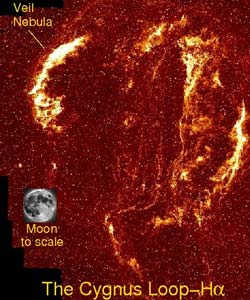FUSE pierces the Veil

An image of the entire Cygnus Loop in the light of hydrogen-alpha, 656.3 nm. (Data courtesy of Nancy Levenson.)
Satellite pins down distance to important exploded star
The Veil Nebula, a delicate network of glowing gaseous filaments in the northern constellation of Cygnus the Swan, has long been a favorite of both amateur and professional astronomers. Part of a much larger nebula known as the Cygnus Loop, the Veil is comprised of the leftovers of a star that exploded between 5,000 and 8,000 years ago.
For at least half a century, scientists have probed the Cygnus Loop with various techniques, trying to understand its physical characteristics as a model for comprehending a whole class of similar objects that cannot be observed in such detail. Even with intensive study, however, many of the Loop’s basic parameters, such as its distance and the density of its gaseous filaments, have been poorly understood.
But a creative new observation of a star situated behind the Veil Nebula may alter the way scientists think about this supernova remnant. At an American Astronomical Society meeting in Denver this week, astronomers from The Johns Hopkins University will provide confirmation that the Cygnus Loop is closer to Earth than many have thought. These new findings, obtained largely using the Far Ultraviolet Spectroscopic Explorer (FUSE) satellite, have a major impact on the derived properties of this important, prototypical object.
“The key to this result was in finding a background star with sufficient far-ultraviolet output to be observed with FUSE,” says William P. Blair, a research professor at The Johns Hopkins University and the principal author of the study.
To identify the candidate star, Blair and his colleagues used an image of the Veil Nebula taken with the Ultraviolet Imaging Telescope on a 1995 space shuttle flight. In the far-ultraviolet, most stars visible at optical wavelengths simply fade away.
“It was a real stroke of luck to find an ultraviolet-bright star located behind the Veil,” Blair said.
Late last year, Blair and his colleagues trained FUSE — a NASA satellite designed at and operated by a team at Johns Hopkins — on the star, known only as KPD2055+311. The resulting spectrum of the star in ultraviolet light shows many absorption lines, or dips, in light intensity. Some of these dips arise in the star’s atmosphere or from cold molecular gas in the interstellar space along the way to the star. But some absorptions, attributable to very hot gas, must arise from the absorption within the Veil Nebula itself.
“Indeed, this confirmed for us that the star is behind the Cygnus Loop,” Blair said.
Part two of the story involves the star itself. Blair’s group used the observed properties of the star and a model of the star’s emission to calculate a distance of 1,860 light years to KPD2055+311. (A light year is the distance light travels in one year, about 6 trillion miles.) Until a few years ago, astronomers placed the Cygnus Loop more than 2,500 light years distant.
In 1999, astronomers using the Hubble Space Telescope revised that estimate to 40 percent closer, or 1,470 light years. Nevertheless, uncertainties and assumptions used in making that estimate left some researchers unpersuaded. Because the star’s distance is well determined and it is located behind the Cygnus Loop, it places an upper boundary on the distance and provides an independent confirmation of the shorter distance scale.
According to Blair, the shorter distance makes “a tremendous difference” in the calculated size, age, energy and average expansion velocity of the supernova remnant compared with previous estimates.
“Since we want to use the Cygnus Loop to scale to similar objects, it is important to have an accurate starting point,” Blair said. “This observation goes a long way toward improving our understanding of this important object.”
Media Contact
All latest news from the category: Physics and Astronomy
This area deals with the fundamental laws and building blocks of nature and how they interact, the properties and the behavior of matter, and research into space and time and their structures.
innovations-report provides in-depth reports and articles on subjects such as astrophysics, laser technologies, nuclear, quantum, particle and solid-state physics, nanotechnologies, planetary research and findings (Mars, Venus) and developments related to the Hubble Telescope.
Newest articles

First-of-its-kind study uses remote sensing to monitor plastic debris in rivers and lakes
Remote sensing creates a cost-effective solution to monitoring plastic pollution. A first-of-its-kind study from researchers at the University of Minnesota Twin Cities shows how remote sensing can help monitor and…

Laser-based artificial neuron mimics nerve cell functions at lightning speed
With a processing speed a billion times faster than nature, chip-based laser neuron could help advance AI tasks such as pattern recognition and sequence prediction. Researchers have developed a laser-based…

Optimising the processing of plastic waste
Just one look in the yellow bin reveals a colourful jumble of different types of plastic. However, the purer and more uniform plastic waste is, the easier it is to…


